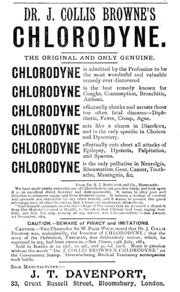
John Thistlewood Davenport
Encyclopedia

Great Russell Street
Great Russell Street is a street in Bloomsbury, central London, England. It is the location of the main entrance of the British Museum to the north. The Congress Centre of the Trades Union Congress is located at number 28...
, London which sold Dr. John Collis Browne
John Collis Browne
Dr. John Collis Browne MRCS was a British Army officer, inventor of items for yachts and the originator of the medicine Chlorodyne. Dr. Browne first used the remedy in India in 1848, when there was a desperate visitation of cholera, whilst he was serving with the 98th Regiment of Foot as their...
's famous 'chlorodyne
Chlorodyne
Chlorodyne was the name for one of the most famous patent medicines sold in the British Isles. It was invented in the 19th century by a Dr. John Collis Browne, a doctor in the British Indian Army; its original purpose was in the treatment of cholera...
.' Davenport served as Vice-President of the Royal Pharmaceutical Society of Great Britain
Royal Pharmaceutical Society of Great Britain
The Royal Pharmaceutical Society of Great Britain was formerly the statutory regulatory and professional body for pharmacists and pharmacy technicians in England, Scotland and Wales...
(formerly the Pharmaceutical Society of Great Britain) from 1853–55 and as its President
President
A president is a leader of an organization, company, trade union, university, or country.Etymologically, a president is one who presides, who sits in leadership...
, 1855-56.
Davenport was nephew of Arthur Thistlewood
Arthur Thistlewood
Arthur Thistlewood was a British conspirator in the Cato Street Conspiracy.-Early life:He was born in Tupholme the extramarital son of a farmer and stockbreeder. He attended Horncastle Grammar School and was trained as a land surveyor. Unsatisfied with his job, he obtained a commission in the army...
, the leader of the Cato Street conspiracy
Cato Street Conspiracy
The Cato Street Conspiracy was an attempt to murder all the British cabinet ministers and Prime Minister Lord Liverpool in 1820. The name comes from the meeting place near Edgware Road in London. The Cato Street Conspiracy is notable due to dissenting public opinions regarding the punishment of the...
. He married Cecilia Hopgood, daughter of Thomas Burn Hopgood (1785–1860), the London silvermaker. His second wife was Eliza Clarendon Forbes, daughter of Captain John Forbes. Amongst his children were Horace Davenport the athlete and Cambridge University's one time representative in the 'mile dash' and Rev. John Metcalf Davenport
John Metcalf Davenport
John Metcalf Davenport was a Church of England clergyman and writer. He began his career as a clerk for his father, a prominent commercial chemist. Following an awakening, he went to Exeter College, Oxford from which he graduated in 1871, the year he became a deacon...
. Davenport's grandson was Hayward Davenport
Hayward Davenport
Hayward Montague Davenport , usually referred to as Hayward M. Davenport, was an English maritime painter and pharmacist. His most notable work is a large watercolour entitled 'Oak and Steel,' which was exhibited at the Royal Academy of Arts in 1894...
who later took over the business.

